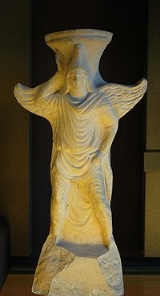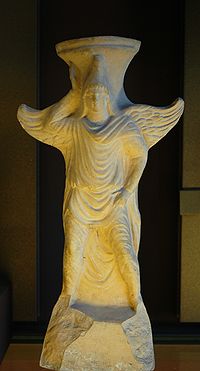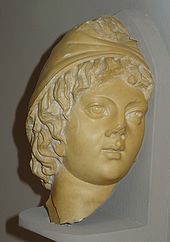
Attis
Encyclopedia
Attis was the consort of Cybele
in Phrygian and Greek mythology
. His priests were eunuch
s, as explained by origin myth
s pertaining to Attis and castration
. Attis was also a Phrygian god of vegetation.
The 19th-century identification with the name Atys
encountered in Herodotus
(i.34-45) as the historical name of the son of Croesus
, as "Atys the sun god, slain by the boar's tusk of winter", are mistaken.
 An Attis cult began around 1200 BCE in Dindymon
An Attis cult began around 1200 BCE in Dindymon
(today's Murat Dağı of Gediz, Kütahya
). He was originally a local semi-deity of Phrygia
, associated with the great Phrygian trading city of Pessinos, which lay under the lee of Mount Agdistis. The mountain was personified as a daemon
, whom foreigners associated with the Great Mother Cybele.
In the late fourth century a cult of Attis became a feature of the Greek world. The story of his origins at Agdistis
, recorded by the traveler Pausanias
, have some distinctly non-Greek elements: Pausanias was told that the daemon Agdistis initially bore both male and female attributes. But the Olympian gods, fearing Agdistis, cut off the male organ and cast it away. There grew up from it an almond-tree, and when its fruit was ripe, Nana who was a daughter of the river-god
Sangarius
picked an almond and laid it in her bosom. The almond disappeared, and she became pregnant. Nana abandoned the baby (Attis). The infant was tended by a he-goat. As Attis grew, his long-haired beauty was godlike, and Agdistis as Cybele, then fell in love with him. But the foster parents of Attis sent him to Pessinos, where he was to wed the king's daughter. According to some versions the King of Pessinos was Midas
. Just as the marriage-song was being sung, Agdistis/Cybele appeared in her transcendent power, and Attis went mad and cut off his genitals. Attis' father-in-law-to-be, the king who was giving his daughter in marriage, followed suit, prefiguring the self-castrating corybantes who devoted themselves to Cybele. But Agdistis repented and saw to it that the body of Attis should neither rot at all nor decay.
At the temple of Cybele in Pessinus, the mother of the gods was still called Agdistis, the geographer Strabo
recounted.
 As neighboring Lydia
As neighboring Lydia
came to control Phrygia, the cult of Attis was given a Lydian context too. Attis is said to have introduced to Lydia the cult of the Mother Goddess Cybele, incurring the jealousy of Zeus
, who sent a boar to destroy the Lydian crops. Then certain Lydians, with Attis himself, were killed by the boar. Pausanias adds, to corroborate this story, that the Gauls who inhabited Pessinos abstained from pork. This myth element may have been invented solely to explain the unusual dietary laws of the Lydian Gauls
. In Rome, the eunuch followers of Cybele were known as Galli
("Gauls").
Julian the Apostate gives an account of the spread of the orgiastic cult of Cybele
in his Oratio 5. It spread from Anatolia to Greece and eventually to Rome in Republican times, and the cult of Attis, her reborn eunuch consort, accompanied her.
The first literary reference to Attis is the subject of one of the most famous poems by Catullus
but it appears that Attis was not worshipped at Rome until the early Empire.
, is in the archaeological museum, Venice.
A finely executed silvery brass Attis that had been ritually consigned to the Mosel
was recovered during construction in 1963 and is kept at the Rheinisches Landesmuseum of Trier. It shows the typically Anatolian costume of the god: trousers fastened together down the front of the legs with toggles and the Phrygian cap
.
In 2007, in the ruins of Herculaneum a wooden throne was discovered adorned with a relief of Attis beneath a sacred pine tree, gathering cones. Various finds suggest that the cult of Attis was popular in Herculaneum at the time of the eruption of Vesuvius in 79 AD
.
Cybele
Cybele , was a Phrygian form of the Earth Mother or Great Mother. As with Greek Gaia , her Minoan equivalent Rhea and some aspects of Demeter, Cybele embodies the fertile Earth...
in Phrygian and Greek mythology
Greek mythology
Greek mythology is the body of myths and legends belonging to the ancient Greeks, concerning their gods and heroes, the nature of the world, and the origins and significance of their own cult and ritual practices. They were a part of religion in ancient Greece...
. His priests were eunuch
Eunuch
A eunuch is a person born male most commonly castrated, typically early enough in his life for this change to have major hormonal consequences...
s, as explained by origin myth
Origin myth
An origin myth is a myth that purports to describe the origin of some feature of the natural or social world. One type of origin myth is the cosmogonic myth, which describes the creation of the world...
s pertaining to Attis and castration
Castration
Castration is any action, surgical, chemical, or otherwise, by which a male loses the functions of the testicles or a female loses the functions of the ovaries.-Humans:...
. Attis was also a Phrygian god of vegetation.
The 19th-century identification with the name Atys
Atys
Atys may mean:*Atys was a king of Alba Longa.*Atys was an early king of Lydia, then referred to as Maeonia, and was the father of Lydus.*Atys son of Croesus was the son of the later King Croesus of Lydia....
encountered in Herodotus
Herodotus
Herodotus was an ancient Greek historian who was born in Halicarnassus, Caria and lived in the 5th century BC . He has been called the "Father of History", and was the first historian known to collect his materials systematically, test their accuracy to a certain extent and arrange them in a...
(i.34-45) as the historical name of the son of Croesus
Croesus
Croesus was the king of Lydia from 560 to 547 BC until his defeat by the Persians. The fall of Croesus made a profound impact on the Hellenes, providing a fixed point in their calendar. "By the fifth century at least," J.A.S...
, as "Atys the sun god, slain by the boar's tusk of winter", are mistaken.
Origins and myths

Dindymon
In Greek mythology, Dindymon , was a mountain in eastern Phrygia , later part of Galatia, that was later called Agdistis, sacred to the "mountain mother", Cybele, whom the Hellenes knew as Rhea...
(today's Murat Dağı of Gediz, Kütahya
Gediz, Kütahya
Gediz is a town and district of Kütahya Province in the Aegean region of Turkey. According to 2000 census, population of the district is 77,483 of which 19,375 live in the town of Gediz.-External links:*...
). He was originally a local semi-deity of Phrygia
Phrygia
In antiquity, Phrygia was a kingdom in the west central part of Anatolia, in what is now modern-day Turkey. The Phrygians initially lived in the southern Balkans; according to Herodotus, under the name of Bryges , changing it to Phruges after their final migration to Anatolia, via the...
, associated with the great Phrygian trading city of Pessinos, which lay under the lee of Mount Agdistis. The mountain was personified as a daemon
Daemon (mythology)
The words dæmon and daimôn are Latinized spellings of the Greek "δαίμων", a reference to the daemons of Ancient Greek religion and mythology, as well as later Hellenistic religion and philosophy...
, whom foreigners associated with the Great Mother Cybele.
In the late fourth century a cult of Attis became a feature of the Greek world. The story of his origins at Agdistis
Agdistis
Agdistis was a deity of Greek, Roman and Anatolian mythology, possessing both male and female sexual organs, connected with the Phrygian worship of Attis and Cybele...
, recorded by the traveler Pausanias
Pausanias (geographer)
Pausanias was a Greek traveler and geographer of the 2nd century AD, who lived in the times of Hadrian, Antoninus Pius and Marcus Aurelius. He is famous for his Description of Greece , a lengthy work that describes ancient Greece from firsthand observations, and is a crucial link between classical...
, have some distinctly non-Greek elements: Pausanias was told that the daemon Agdistis initially bore both male and female attributes. But the Olympian gods, fearing Agdistis, cut off the male organ and cast it away. There grew up from it an almond-tree, and when its fruit was ripe, Nana who was a daughter of the river-god
Water deity
A water deity is a deity in mythology associated with water or various bodies of water. Water deities are common in mythology and were usually more important among civilizations in which the sea or ocean, or a great river was more important...
Sangarius
Sangarius (mythology)
Sangarius is a Phrygian river-god of Greek mythology. He is described as the son of Oceanus and Tethys, and as the husband of Metope, by whom he became the father of Hecuba. He is also the father of Nana and therefore the grandfather of Attis...
picked an almond and laid it in her bosom. The almond disappeared, and she became pregnant. Nana abandoned the baby (Attis). The infant was tended by a he-goat. As Attis grew, his long-haired beauty was godlike, and Agdistis as Cybele, then fell in love with him. But the foster parents of Attis sent him to Pessinos, where he was to wed the king's daughter. According to some versions the King of Pessinos was Midas
Midas
For the legend of Gordias, a person who was taken by the people and made King, in obedience to the command of the oracle, see Gordias.Midas or King Midas is popularly remembered in Greek mythology for his ability to turn everything he touched into gold. This was called the Golden touch, or the...
. Just as the marriage-song was being sung, Agdistis/Cybele appeared in her transcendent power, and Attis went mad and cut off his genitals. Attis' father-in-law-to-be, the king who was giving his daughter in marriage, followed suit, prefiguring the self-castrating corybantes who devoted themselves to Cybele. But Agdistis repented and saw to it that the body of Attis should neither rot at all nor decay.
At the temple of Cybele in Pessinus, the mother of the gods was still called Agdistis, the geographer Strabo
Strabo
Strabo, also written Strabon was a Greek historian, geographer and philosopher.-Life:Strabo was born to an affluent family from Amaseia in Pontus , a city which he said was situated the approximate equivalent of 75 km from the Black Sea...
recounted.

Lydia
Lydia was an Iron Age kingdom of western Asia Minor located generally east of ancient Ionia in the modern Turkish provinces of Manisa and inland İzmir. Its population spoke an Anatolian language known as Lydian....
came to control Phrygia, the cult of Attis was given a Lydian context too. Attis is said to have introduced to Lydia the cult of the Mother Goddess Cybele, incurring the jealousy of Zeus
Zeus
In the ancient Greek religion, Zeus was the "Father of Gods and men" who ruled the Olympians of Mount Olympus as a father ruled the family. He was the god of sky and thunder in Greek mythology. His Roman counterpart is Jupiter and his Etruscan counterpart is Tinia.Zeus was the child of Cronus...
, who sent a boar to destroy the Lydian crops. Then certain Lydians, with Attis himself, were killed by the boar. Pausanias adds, to corroborate this story, that the Gauls who inhabited Pessinos abstained from pork. This myth element may have been invented solely to explain the unusual dietary laws of the Lydian Gauls
Galatia
Ancient Galatia was an area in the highlands of central Anatolia in modern Turkey. Galatia was named for the immigrant Gauls from Thrace , who settled here and became its ruling caste in the 3rd century BC, following the Gallic invasion of the Balkans in 279 BC. It has been called the "Gallia" of...
. In Rome, the eunuch followers of Cybele were known as Galli
Galli
A Gallus was a eunuch priest of the Phrygian goddess Cybele, whose worship was incorporated into the state religious practices of ancient Rome.-About the Galli:...
("Gauls").
Julian the Apostate gives an account of the spread of the orgiastic cult of Cybele
Cybele
Cybele , was a Phrygian form of the Earth Mother or Great Mother. As with Greek Gaia , her Minoan equivalent Rhea and some aspects of Demeter, Cybele embodies the fertile Earth...
in his Oratio 5. It spread from Anatolia to Greece and eventually to Rome in Republican times, and the cult of Attis, her reborn eunuch consort, accompanied her.
The first literary reference to Attis is the subject of one of the most famous poems by Catullus
Catullus
Gaius Valerius Catullus was a Latin poet of the Republican period. His surviving works are still read widely, and continue to influence poetry and other forms of art.-Biography:...
but it appears that Attis was not worshipped at Rome until the early Empire.
Archaeological finds
A marble bas-relief of Cybele in her chariot and Attis, from Magna GraeciaMagna Graecia
Magna Græcia is the name of the coastal areas of Southern Italy on the Tarentine Gulf that were extensively colonized by Greek settlers; particularly the Achaean colonies of Tarentum, Crotone, and Sybaris, but also, more loosely, the cities of Cumae and Neapolis to the north...
, is in the archaeological museum, Venice.
A finely executed silvery brass Attis that had been ritually consigned to the Mosel
Mosel
Mosel may mean the following:* Moselle , a European river, named Mosel in German* Mosel , a German appellation, formerly known as Mosel-Saar-Ruwer** Mosel wine, wine produced in the region...
was recovered during construction in 1963 and is kept at the Rheinisches Landesmuseum of Trier. It shows the typically Anatolian costume of the god: trousers fastened together down the front of the legs with toggles and the Phrygian cap
Phrygian cap
The Phrygian cap is a soft conical cap with the top pulled forward, associated in antiquity with the inhabitants of Phrygia, a region of central Anatolia. In the western provinces of the Roman Empire it came to signify freedom and the pursuit of liberty, perhaps through a confusion with the pileus,...
.
In 2007, in the ruins of Herculaneum a wooden throne was discovered adorned with a relief of Attis beneath a sacred pine tree, gathering cones. Various finds suggest that the cult of Attis was popular in Herculaneum at the time of the eruption of Vesuvius in 79 AD
79
Year 79 was a common year starting on Friday of the Julian calendar. At the time, it was known as the Year of the Consulship of Augustus and Vespasianus...
.
Selected bibliography
- M. J. Vermaseren, Cybele and Attis, Thames & Hudson, London, 1977.
- P. Lambrechts, Attis: Van Herdersknaap tot God (Brussels:Vlaamse Akademie) 1962. (French summary)
- Reviewed by J.A. North in The Journal of Roman Studies 55.1/2 (1965), p. 278-279.
- H. Hepding, Attis seine Mythen und sein Kult (Religionsgeschichtliche Versuche und Vorarbeiten I), Giessen, 1903.
- E.N. Lane (ed.), Cybele, Attis and Related Cults. Essays in Memory of M.J. Vermaseren. (Religions in the Graeco-Roman World, 131), Leiden-Köln, 1996.

